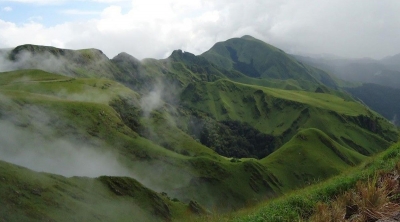
Covering an area of more than 180 sq.km., the Mount Nimba Strict Nature Reserve is located in the western part of Africa, straddling the borders of Guinea and Cote d’Ivoire. Towering over the region is Mount Nimba. One of the highest elevation forest ecosystems in this part of the continent, the area is a stunning mosaic of valleys, plateaus, and cliffs. The slopes of the mountain are marked by dense forests and savannahs, offering fantastic habitats for a wide variety of flora and fauna, many of them endemic to the region. The Reserve is said to support more than 2,000 species of plants, 300 species of vertebrates, and 2.500 species of invertebrates. Among its most noted endemic species are micropotamogale (otter shrew- an insectivore), the viviparous toad (unusually for a reptile, it gives birth to young ones rather than lay eggs), and “chimpanzees capable of using tools”. These creatures, however, are critically endangered or are on the brink of extinction. In fact, this Reserve was declared a UNESCO World Heritage Site in 1981 for its “Outstanding Universal Value”. But, 11 years from then, it fell under the “List of World Heritage in Danger, and remains there. While activities such as poaching and clearing the land for agriculture have had a negative bearing on the Reserve, long-term mining just outside of it too has been a cause of grave concern.
Wildlife
Among the birds that can be spotted here are ducks, garganeys, guineafowls, quails, francolins, grebes, pigeons, doves, nightjars, swifts, coucals, cuckoos, rails, flufftails. Turacos, storks, herons, bitterns, egrets, ibises, stilts, lapwings, plovers, jacanas, sandpipers, kites, buzzards, vultures, hawks, eagles, owls, owlets, trogons, hombills, hoopoes, honeyguides, woodpeckers, barbets, tinkerbirds, bee-eaters, rollers, kingfishers, falcons, kestrels, pittas, broadbills, orioles, cuckooshrikes, flycatchers, drongos, sunbirds, weavers, finches, waxbills, sparrows, pipits, buntings, larks, warblers, swallows, martins, babblers, starlings, and robins.
Threats
The conservation outlook for this site has been assessed as “critical” in the latest assessment cycle (2020) by the International Union for Conservation of Nature. According to the report, several aspects such as poaching, bush fires, and increasing human activity on the periphery of the Reserve are all together putting pressure on it, and causing “progressive ecological isolation of the region. Adding to the concern is the fact that “the buffer zone is not very functional in Guinea and does not exist in Ivory Coast”. Further, many iron mining projects happen to occur close to Reserve’s boundaries in Guinea. This points to open pit mining, and it could have a negative impact on wildlife, especially key species, and habitats, particularly if their effects are continuous. Though the Reserve straddles the borders of two countries, there is no transboundary master plan in place. In fact there is no common management system for the whole region either. This could be one of the main reasons for poaching. It could also be aggravated by the lack of good monitoring. Unlike in many regions across the world local communities here are not engaged that well in conservation initiatives or for that matter, even the development of alternative income generating activities is insufficient to reduce the pressure on natural resources”.
Picture Credit : Google



